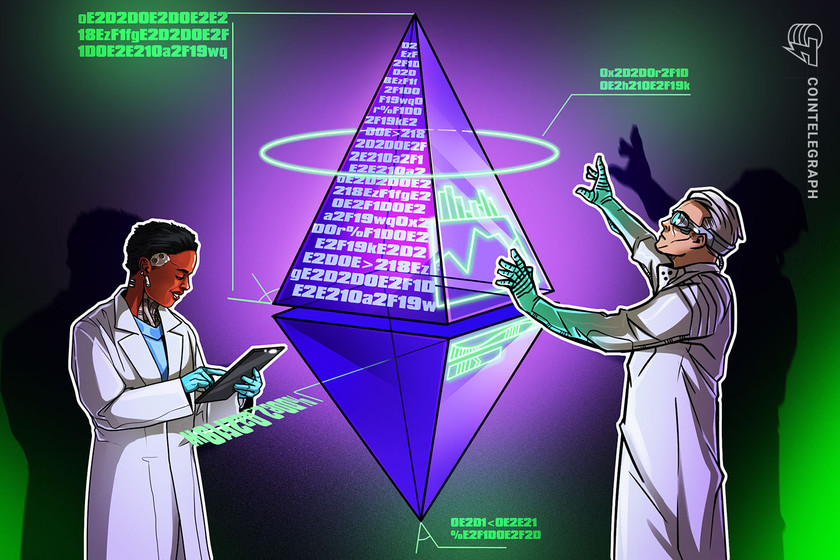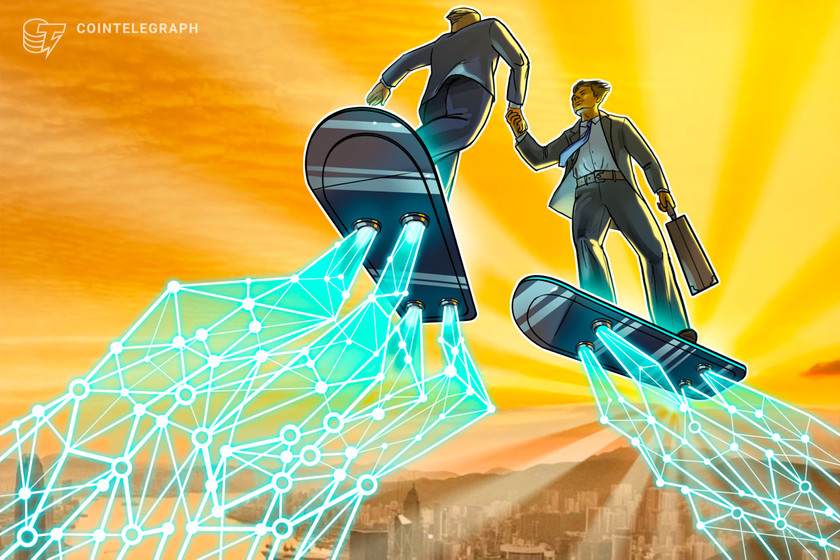How to stake cryptocurrencies in 2022, explained
What is Bitcoin? How does blockchain work? How to mine cryptocurrency? We are glad to help you answer these questions with our quick guides in Explained section.
rn”,”seo_description”:”What is Bitcoin? How does blockchain work? How to mine cryptocurrency? We are glad to help you answer these questions with our quick guides in Explained section.”},”words_count”:645,”description”:”PoS has evolved to include several evolutions, providing users new ways to participate in transaction validation and earn passive income”,”author”:{“id”:1347,”title”:”Sarah Jansen”,”url”:”sarah-jansen”,”twitter”:””,”google_plus”:””,”photo”:”https://s3.cointelegraph.com/storage/uploads/view/87b0b4c392f9abc8f9ad3be57cacdbfd.jpg”,”gender”:”female”,”description”:”Sarah Jansen is a seasoned marketing professional and cryptocurrency enthusiast. After graduating with a Bachelors Degree in Marketing from the University of Calgary, she began writing for a number of cryptocurrency news sites and exchanges. She continues to share her passion for writing through her work in the DeFi, FinTech and IoT space.”,”facebook”:””,”email”:””,”linkedin”:””,”created_at”:”2021-08-16 14:46:18″,”updated_at”:”2021-10-20 16:04:34″,”deleted_at”:null,”avatar”:”https://images.cointelegraph.com/images/150_aHR0cHM6Ly9zMy5jb2ludGVsZWdyYXBoLmNvbS9zdG9yYWdlL3VwbG9hZHMvdmlldy84N2IwYjRjMzkyZjlhYmM4ZjlhZDNiZTU3Y2FjZGJmZC5qcGc=.jpg”,”hash”:”aHR0cHM6Ly9jb2ludGVsZWdyYXBoLmNvbS9hdXRob3JzL3NhcmFoLWphbnNlbg==”,”relativeUrl”:”https://cointelegraph.com/authors/sarah-jansen”,”user_id”:1347,”language_id”:1,”name”:”Sarah Jansen”,”desc”:”Sarah Jansen is a seasoned marketing professional and cryptocurrency enthusiast. After graduating with a Bachelors Degree in Marketing from the University of Calgary, she began writing for a number of cryptocurrency news sites and exchanges. She continues to share her passion for writing through her work in the DeFi, FinTech and IoT space.”,”seo_title”:””,”seo_description”:””,”enabled”:1,”show_in_authors”:0,”show_in_experts”:0},”category_id”:65,”audio”:”https://s3.cointelegraph.com/audio/82069.b102475f-e9b8-403c-b236-b2ffcf40b6ce.mp3″,”tags”:[{“name”:”Blockchain”,”uri”:”/tags/blockchain”,”super”:1,”page_title”:”Blockchain News”},{“name”:”Cryptocurrencies”,”uri”:”/tags/cryptocurrencies”,”super”:0,”page_title”:”Cryptocurrencies News”},{“name”:”Proof-of-Stake”,”uri”:”/tags/proof-of-stake”,”super”:0,”page_title”:”Proof-of-Stake News”}],”tag_title”:”Blockchain”,”date”:”43 MINUTES AGO”,”badge”:{“title”:”Explained”,”label”:”default”},”qty”:19,”stats_pixel”:”“,”stats_pixel_url”:”https://zoa.cointelegraph.com/pixel?postId=82069®ionId=1″,”shares”:4,”infographic”:false,”sponsored”:false,”explained”:true,”press_release”:false,”show_referral”:false,”social_description”:””,”social_translators”:{“clipboard_popup_label”:”Link copied”,”socialWechatFooterError”:”WeChat error”,”socialWechatFooterText”:”WeChat share”,”socialWechatHeaderText”:”WeChat share”},”social_shares”:{“post_id”:82069,”post_url”:”https://cointelegraph.com/explained/how-to-stake-cryptocurrencies-in-2022-explained”,”post_titles”:{“normal”:”How to stake cryptocurrencies in 2022, explained”,”twitter”:”How to stake cryptocurrencies in 2022, explained”},”post_text”:{“normal”:”How to stake cryptocurrencies in 2022, explained”,”twitter”:”How to stake cryptocurrencies in 2022, explained https://cointelegraph.com/explained/how-to-stake-cryptocurrencies-in-2022-explained via @cointelegraph”},”accounts”:{“twitter”:”@cointelegraph”}},”socials”:{“facebook”:{“url”:”https://www.facebook.com/sharer/sharer.php?u=https%3A%2F%2Fcointelegraph.com%2Fexplained%2Fhow-to-stake-cryptocurrencies-in-2022-explained”,”count”:null,”short”:”fb”,”fa”:”facebook”},”twitter”:{“url”:”https://twitter.com/intent/tweet?text=How+to+stake+cryptocurrencies+in+2022%2C+explained https%3A%2F%2Fcointelegraph.com%2Fexplained%2Fhow-to-stake-cryptocurrencies-in-2022-explained via @cointelegraph”,”count”:null,”short”:”tw”,”fa”:”twitter”},”telegram”:{“url”:”https://telegram.me/share/url?url=https%3A%2F%2Fcointelegraph.com%2Fexplained%2Fhow-to-stake-cryptocurrencies-in-2022-explained &text=How+to+stake+cryptocurrencies+in+2022%2C+explained”,”count”:null,”short”:”tg”,”fa”:”paper-plane”},”whatsapp”:{“url”:”https://api.whatsapp.com/send?text=How+to+stake+cryptocurrencies+in+2022%2C+explained&href=https%3A%2F%2Fcointelegraph.com%2Fexplained%2Fhow-to-stake-cryptocurrencies-in-2022-explained”,”count”:null,”short”:”wu”,”fa”:”whatsapp”},”gplus”:{“url”:”https://plus.google.com/share?url=https%3A%2F%2Fcointelegraph.com%2Fexplained%2Fhow-to-stake-cryptocurrencies-in-2022-explained”,”count”:null,”short”:”gplus”,”fa”:”google-plus”},”reddit”:{“url”:”https://www.reddit.com/submit?url=https%3A%2F%2Fcointelegraph.com%2Fexplained%2Fhow-to-stake-cryptocurrencies-in-2022-explained&title=How+to+stake+cryptocurrencies+in+2022%2C+explained”,”count”:null,”short”:”reddit”,”fa”:”reddit-alien”},”linkedin”:{“url”:”https://www.linkedin.com/shareArticle?mini=true&url=https%3A%2F%2Fcointelegraph.com%2Fexplained%2Fhow-to-stake-cryptocurrencies-in-2022-explained&title=How+to+stake+cryptocurrencies+in+2022%2C+explained”,”count”:null,”short”:”li”,”fa”:”linkedin”}},”hide_disclaimer”:false,”elink”:”https://hitbtc.com/”,”etitle”:”Partnership material”,”elogo_x2″:”https://images.cointelegraph.com/images/528_aHR0cHM6Ly9zMy5jb2ludGVsZWdyYXBoLmNvbS9zdG9yYWdlL3VwbG9hZHMvdmlldy9lZWIwNTMwMTA5NzZlN2I0OWFkMTBlNmQ4MzNmNTY4My5wbmc=.png”,”elogo_x1″:”https://images.cointelegraph.com/images/260_aHR0cHM6Ly9zMy5jb2ludGVsZWdyYXBoLmNvbS9zdG9yYWdlL3VwbG9hZHMvdmlldy9lZWIwNTMwMTA5NzZlN2I0OWFkMTBlNmQ4MzNmNTY4My5wbmc=.png”,”elogo_svg”:false,”content”:[{“id”:3215,”post_id”:82069,”title”:”What is staking?”,”content”:”
Staking is the process of allowing users to earn a percentage rate as a reward for holding tokens that are put to work on the blockchain.
nn
Staking comes from the word “stake,” referring to the sharing of profits and deriving a passive income from cryptocurrencies through a consensus mechanism called proof-of-stake or the PoS algorithm and its variations. The basic principle is that users can stake some of the coins held in their wallets to earn a percentage-rate reward over time. PoS enables these rewards since the blockchain is putting these tokens to work through transaction validation.
nnn”,”created_at”:”2022-03-01 14:30:29″,”updated_at”:”2022-03-01 14:34:26″,”sort”:1,”translations”:{“id”:3208,”explained_post_id”:3215,”title_en”:”What is staking?”,”content_en”:”
Staking is the process of allowing users to earn a percentage rate as a reward for holding tokens that are put to work on the blockchain.
nn
Staking comes from the word “stake,” referring to the sharing of profits and deriving a passive income from cryptocurrencies through a consensus mechanism called proof-of-stake or the PoS algorithm and its variations. The basic principle is that users can stake some of the coins held in their wallets to earn a percentage-rate reward over time. PoS enables these rewards since the blockchain is putting these tokens to work through transaction validation.
nnn”,”title_es”:””,”content_es”:”n”,”title_cn”:””,”content_cn”:”n”,”title_de”:””,”content_de”:”n”,”title_it”:””,”content_it”:”n”,”title_ar”:””,”content_ar”:”n”,”title_br”:””,”content_br”:”n”,”title_jp”:””,”content_jp”:”n”,”created_at”:”2022-03-01 14:30:29″,”updated_at”:”2022-03-01 14:34:26″,”title_kr”:””,”content_kr”:”n”,”title_tr”:””,”content_tr”:”n”}},{“id”:3216,”post_id”:82069,”title”:”What is the proof-of-stake algorithm?”,”content”:”
The proof-of-stake algorithm originated back in 2012 with the idea that holding a stake of tokens could be used to determine which node would be eligible to mine the next block.
nn
PoS refers to a cryptocurrency consensus algorithm that processes transactions and creates new blocks. In 2012, PPCoin (now PeerCoin) used the idea that a stake could determine which node would be eligible to mine the next block. Simply put, a minimum number of coins need to be staked for a user to become a validator; however, the more coins that are owned, the greater the chance they may become the next block creator.
nnn”,”created_at”:”2022-03-01 14:30:57″,”updated_at”:”2022-03-01 14:34:26″,”sort”:2,”translations”:{“id”:3209,”explained_post_id”:3216,”title_en”:”What is the proof-of-stake algorithm?”,”content_en”:”
The proof-of-stake algorithm originated back in 2012 with the idea that holding a stake of tokens could be used to determine which node would be eligible to mine the next block.
nn
PoS refers to a cryptocurrency consensus algorithm that processes transactions and creates new blocks. In 2012, PPCoin (now PeerCoin) used the idea that a stake could determine which node would be eligible to mine the next block. Simply put, a minimum number of coins need to be staked for a user to become a validator; however, the more coins that are owned, the greater the chance they may become the next block creator.
nnn”,”title_es”:””,”content_es”:”n”,”title_cn”:””,”content_cn”:”n”,”title_de”:””,”content_de”:”n”,”title_it”:””,”content_it”:”n”,”title_ar”:””,”content_ar”:”n”,”title_br”:””,”content_br”:”n”,”title_jp”:””,”content_jp”:”n”,”created_at”:”2022-03-01 14:30:57″,”updated_at”:”2022-03-01 14:34:26″,”title_kr”:””,”content_kr”:”n”,”title_tr”:””,”content_tr”:”n”}},{“id”:3217,”post_id”:82069,”title”:”What are the different PoS versions?”,”content”:”
PoS evolutions have come to include DPoS (delegated proof-of-stake), leased proof-of-stake (LPoS), proof-of-stake velocity (PoSV) and proof-of-storage, amongst others.
nn
While PoS offers many advantages over the proof-of-work (PoW) consensus mechanism, newer projects have emerged to further enhance these versions. As a result, most cryptocurrencies that deploy this model use hybrid modifications such as DPoS, a version that introduced delegates, LPoS to incentivize smaller token holders, proof-of-stake velocity (PoSV), proof based on the hard drive space and proof-of-storage, proof of storage of the total amount of blocks. Each of these PoS variants exists to improve efficiency and provide the best process for the end-user.
nnn”,”created_at”:”2022-03-01 14:31:24″,”updated_at”:”2022-03-01 14:34:26″,”sort”:3,”translations”:{“id”:3210,”explained_post_id”:3217,”title_en”:”What are the different PoS versions?”,”content_en”:”
PoS evolutions have come to include DPoS (delegated proof-of-stake), leased proof-of-stake (LPoS), proof-of-stake velocity (PoSV) and proof-of-storage, amongst others.
nn
While PoS offers many advantages over the proof-of-work (PoW) consensus mechanism, newer projects have emerged to further enhance these versions. As a result, most cryptocurrencies that deploy this model use hybrid modifications such as DPoS, a version that introduced delegates, LPoS to incentivize smaller token holders, proof-of-stake velocity (PoSV), proof based on the hard drive space and proof-of-storage, proof of storage of the total amount of blocks. Each of these PoS variants exists to improve efficiency and provide the best process for the end-user.
nnn”,”title_es”:””,”content_es”:”n”,”title_cn”:””,”content_cn”:”n”,”title_de”:””,”content_de”:”n”,”title_it”:””,”content_it”:”n”,”title_ar”:””,”content_ar”:”n”,”title_br”:””,”content_br”:”n”,”title_jp”:””,”content_jp”:”n”,”created_at”:”2022-03-01 14:31:24″,”updated_at”:”2022-03-01 14:34:26″,”title_kr”:””,”content_kr”:”n”,”title_tr”:””,”content_tr”:”n”}},{“id”:3218,”post_id”:82069,”title”:”What is delegated proof-of-stake (DPoS)?”,”content”:”
DPoS is a version of PoS where participants can pool tokens in a staking pool to determine a block validator.
nn
In 2013, Daniel Larimer developed an evolution of PoS in which validators are joined by a new group, the delegates. In the resulting Delegated Proof of Stake (DPoS), delegates exist as representatives from the community, as indicated by those holding tokens. These ones can then vote on which validator could create a new block and become entitled to a reward paid through transaction fees. Delegates would also be required to authorize the network rules and maintain the blockchain’s stability, a position that any network member could hold, although only for a short time.
nn
Any user engaged in the staking process and eligible to become a delegate is referred to as a “witness,” the name stemming from their ability to witness transactions and act as nodes in the network. That said, unlike delegates, a witness does not have the opportunity to set the basic network rules. Both witnesses and delegates are voted on through a reputation model.
nn
Tokens in DPoS-based blockchains are divided into tokens available (those in circulation) and those held in the stakes. Each user independently determines their stake amount, and, once selected, the stake may not be spent. These coins can only be used to become a witness, vote for delegates, and participate in network management via smart contracts. The concept is currently applied in projects including Tron (TRX) and EOS.
nnn”,”created_at”:”2022-03-01 14:32:00″,”updated_at”:”2022-03-01 14:34:26″,”sort”:4,”translations”:{“id”:3211,”explained_post_id”:3218,”title_en”:”What is delegated proof-of-stake (DPoS)?”,”content_en”:”
DPoS is a version of PoS where participants can pool tokens in a staking pool to determine a block validator.
nn
In 2013, Daniel Larimer developed an evolution of PoS in which validators are joined by a new group, the delegates. In the resulting Delegated Proof of Stake (DPoS), delegates exist as representatives from the community, as indicated by those holding tokens. These ones can then vote on which validator could create a new block and become entitled to a reward paid through transaction fees. Delegates would also be required to authorize the network rules and maintain the blockchain’s stability, a position that any network member could hold, although only for a short time.
nn
Any user engaged in the staking process and eligible to become a delegate is referred to as a “witness,” the name stemming from their ability to witness transactions and act as nodes in the network. That said, unlike delegates, a witness does not have the opportunity to set the basic network rules. Both witnesses and delegates are voted on through a reputation model.
nn
Tokens in DPoS-based blockchains are divided into tokens available (those in circulation) and those held in the stakes. Each user independently determines their stake amount, and, once selected, the stake may not be spent. These coins can only be used to become a witness, vote for delegates, and participate in network management via smart contracts. The concept is currently applied in projects including Tron (TRX) and EOS.
nnn”,”title_es”:””,”content_es”:”n”,”title_cn”:””,”content_cn”:”n”,”title_de”:””,”content_de”:”n”,”title_it”:””,”content_it”:”n”,”title_ar”:””,”content_ar”:”n”,”title_br”:””,”content_br”:”n”,”title_jp”:””,”content_jp”:”n”,”created_at”:”2022-03-01 14:32:00″,”updated_at”:”2022-03-01 14:34:26″,”title_kr”:””,”content_kr”:”n”,”title_tr”:””,”content_tr”:”n”}},{“id”:3219,”post_id”:82069,”title”:”How does PoS-based staking work?”,”content”:”
POS-based staking allows users to verify transactions based on the number of coins stored in their wallets.
nn
In the Proof of Stake mining algorithm, the validity of users’ transactions is verified based on the coins stored in their wallets. By hashing the users’ transactions data, the algorithm verifies the transaction and updates the blockchain records. In the PoS algorithm, the average level of mining difficulty and its profitability is inverse to the number of tokens held by the specific pool or node.
nn
Since mining tokens via the PoS algorithm does not require computing power, the pool participants are not referred to as “miners,” like those involved in mining cryptocurrencies via the PoW algorithm. In this case, these ones are referred to as “forgers.” Forgers earn a commission, although it is limited to the commission for conducting transactions. Subsequently, their income is determined by the “age” of the token, which is calculated by multiplying the total number of tokens by the length of their storage by the forger. Any user holding a certain number of tokens on their account, which varies depending on the network, can become a forger.
nnn”,”created_at”:”2022-03-01 14:32:34″,”updated_at”:”2022-03-01 14:34:24″,”sort”:5,”translations”:{“id”:3212,”explained_post_id”:3219,”title_en”:”How does PoS-based staking work?”,”content_en”:”
POS-based staking allows users to verify transactions based on the number of coins stored in their wallets.
nn
In the Proof of Stake mining algorithm, the validity of users’ transactions is verified based on the coins stored in their wallets. By hashing the users’ transactions data, the algorithm verifies the transaction and updates the blockchain records. In the PoS algorithm, the average level of mining difficulty and its profitability is inverse to the number of tokens held by the specific pool or node.
nn
Since mining tokens via the PoS algorithm does not require computing power, the pool participants are not referred to as “miners,” like those involved in mining cryptocurrencies via the PoW algorithm. In this case, these ones are referred to as “forgers.” Forgers earn a commission, although it is limited to the commission for conducting transactions. Subsequently, their income is determined by the “age” of the token, which is calculated by multiplying the total number of tokens by the length of their storage by the forger. Any user holding a certain number of tokens on their account, which varies depending on the network, can become a forger.
nnn”,”title_es”:””,”content_es”:”n”,”title_cn”:””,”content_cn”:”n”,”title_de”:””,”content_de”:”n”,”title_it”:””,”content_it”:”n”,”title_ar”:””,”content_ar”:”n”,”title_br”:””,”content_br”:”n”,”title_jp”:””,”content_jp”:”n”,”created_at”:”2022-03-01 14:32:34″,”updated_at”:”2022-03-01 14:34:24″,”title_kr”:””,”content_kr”:”n”,”title_tr”:””,”content_tr”:”n”}},{“id”:3220,”post_id”:82069,”title”:”Who can participate in the PoS-based staking process?”,”content”:”
PoS enables just about any user with a notebook to participate in staking, with advanced exchanges simplifying the user’s experience.
nn
Today, anyone can forge tokens via PoS since no costly equipment, like ASICs, cooling or autonomous power supply systems are needed. Instead, a user can participate in staking with a notebook or desktop computer. To further lower the barriers to begin, the once considerable number of tokens in their accounts accumulate the necessary stake sooner; forgers will join a pool or “master node.”
nn
Platforms like HitBTC have made it their mission to simplify the staking process while enabling users to still earn profitable rewards. Being one of the most advanced Bitcoin exchanges available, HitBTC is making its aim to make cryptocurrencies accessible to everyone, including both those who are institutional clients and individual investors. To achieve this, a significant pillar of their goal comes down to creating one of the deepest liquidity pools in the decentralized finance (DeFi) space and providing an associated staking rewards option.
nn
nn
Disclaimer. Cointelegraph does not endorse any content or product on this page. While we aim at providing you with all important information that we could obtain, readers should do their own research before taking any actions related to the company and carry full responsibility for their decisions, nor can this article be considered as investment advice.
n
nnn”,”created_at”:”2022-03-01 14:33:54″,”updated_at”:”2022-03-01 14:34:24″,”sort”:6,”translations”:{“id”:3213,”explained_post_id”:3220,”title_en”:”Who can participate in the PoS-based staking process?”,”content_en”:”
PoS enables just about any user with a notebook to participate in staking, with advanced exchanges simplifying the user’s experience.
nn
Today, anyone can forge tokens via PoS since no costly equipment, like ASICs, cooling or autonomous power supply systems are needed. Instead, a user can participate in staking with a notebook or desktop computer. To further lower the barriers to begin, the once considerable number of tokens in their accounts accumulate the necessary stake sooner; forgers will join a pool or “master node.”
nn
Platforms like HitBTC have made it their mission to simplify the staking process while enabling users to still earn profitable rewards. Being one of the most advanced Bitcoin exchanges available, HitBTC is making its aim to make cryptocurrencies accessible to everyone, including both those who are institutional clients and individual investors. To achieve this, a significant pillar of their goal comes down to creating one of the deepest liquidity pools in the decentralized finance (DeFi) space and providing an associated staking rewards option.
nn
nn
Disclaimer. Cointelegraph does not endorse any content or product on this page. While we aim at providing you with all important information that we could obtain, readers should do their own research before taking any actions related to the company and carry full responsibility for their decisions, nor can this article be considered as investment advice.
n
nnn”,”title_es”:””,”content_es”:”n”,”title_cn”:””,”content_cn”:”n”,”title_de”:””,”content_de”:”n”,”title_it”:””,”content_it”:”n”,”title_ar”:””,”content_ar”:”n”,”title_br”:””,”content_br”:”n”,”title_jp”:””,”content_jp”:”n”,”created_at”:”2022-03-01 14:33:54″,”updated_at”:”2022-03-01 14:34:24″,”title_kr”:””,”content_kr”:”n”,”title_tr”:””,”content_tr”:”n”}}],”is_partner_material”:true,”commentsSection”:{“schemaEntityUrl”:”//cointelegraph.com/explained/how-to-stake-cryptocurrencies-in-2022-explained”,”list”:[],”amount”:0,”i18n”:{“addComment”:”Add a comment…”,”amountOnePostfix”:”Comment”,”amountPostfix”:”Comments”,”cancel”:”Cancel”,”delete”:”Delete”,”edit”:”Edit”,”errorBig”:”Comment text cannot be longer than 2000 characters”,”errorDuplicate”:”Duplicate comment”,”errorSmall”:”Comment text must be at least 2 characters long”,”hideButton”:”Hide comments”,”noComments”:” “,”commentOnModeration”:”Comment on moderation”,”postComment”:”Post”,”reply”:”Reply”,”showAllComments”:”Show All Comments”,”showButtonPostfix”:”comments”,”showButtonPrefix”:”Show”,”signIn”:”Sign in”,”update”:”Update comment”,”commentWasDeleted”:”This comment has been deleted”}},”related”:[{“id”:47022,”retina”:”https://images.cointelegraph.com/images/1480_aHR0cHM6Ly9zMy5jb2ludGVsZWdyYXBoLmNvbS9zdG9yYWdlL3VwbG9hZHMvdmlldy80Mjk0ZDgxY2IyMTc3MzNlMzI4OGQzMWM3NmIzMGQ1NS5qcGc=.jpg”,”img”:”https://images.cointelegraph.com/images/740_aHR0cHM6Ly9zMy5jb2ludGVsZWdyYXBoLmNvbS9zdG9yYWdlL3VwbG9hZHMvdmlldy80Mjk0ZDgxY2IyMTc3MzNlMzI4OGQzMWM3NmIzMGQ1NS5qcGc=.jpg”,”thumb”:”https://images.cointelegraph.com/images/370_aHR0cHM6Ly9zMy5jb2ludGVsZWdyYXBoLmNvbS9zdG9yYWdlL3VwbG9hZHMvdmlldy80Mjk0ZDgxY2IyMTc3MzNlMzI4OGQzMWM3NmIzMGQ1NS5qcGc=.jpg”,”thumb370″:”https://images.cointelegraph.com/images/370_aHR0cHM6Ly9zMy5jb2ludGVsZWdyYXBoLmNvbS9zdG9yYWdlL3VwbG9hZHMvdmlldy80Mjk0ZDgxY2IyMTc3MzNlMzI4OGQzMWM3NmIzMGQ1NS5qcGc=.jpg”,”amp_thumb”:”https://images.cointelegraph.com/images/150_aHR0cHM6Ly9zMy5jb2ludGVsZWdyYXBoLmNvbS9zdG9yYWdlL3VwbG9hZHMvdmlldy80Mjk0ZDgxY2IyMTc3MzNlMzI4OGQzMWM3NmIzMGQ1NS5qcGc=.jpg”,”thumb150″:”https://images.cointelegraph.com/images/150_aHR0cHM6Ly9zMy5jb2ludGVsZWdyYXBoLmNvbS9zdG9yYWdlL3VwbG9hZHMvdmlldy80Mjk0ZDgxY2IyMTc3MzNlMzI4OGQzMWM3NmIzMGQ1NS5qcGc=.jpg”,”url”:”https://cointelegraph.com/news/eth-miners-will-have-little-choice-once-ethereum-20-launches-with-pos”,”title”:”ETH Miners Will Have Little Choice Once Ethereum 2.0 Launches With PoS”,”lead”:”Once Ethereum becomes a proof-of-stake blockchain, what will happen to the ETH miners, and what will they do?”,”leadfull”:””,”category_id”:19,”category_url”:”https://cointelegraph.com/category/analysis”,”category_title”:”Analysis”,”author_url”:”https://cointelegraph.com/authors/stephen-oneal”,”author_hash”:”aHR0cHM6Ly9jb2ludGVsZWdyYXBoLmNvbS9hdXRob3JzL3N0ZXBoZW4tb25lYWw=”,”author_title”:”Stephen O’Neal”,”author_img”:”https://images.cointelegraph.com/images/32_aHR0cHM6Ly9zMy5jb2ludGVsZWdyYXBoLmNvbS9zdG9yYWdlL3VwbG9hZHMvdmlldy9kMWExMThjNzdmYzdkYjc3NjUzYjliNTk2MGYxYzBmZC5qcGc=.jpg”,”date”:”JUN 13, 2020″,”flash_date”:”JUN 13, 2020″,”sponsored”:false,”press_release”:false,”sponsored_label”:”Sponsored”,”explained”:false,”badge”:{“title”:”Analysis”,”label”:”info”},”published”:{“date”:”2020-06-13 12:45:00.000000″,”timezone_type”:3,”timezone”:”Europe/London”},”stat_uniqs”:454065,”rss_date”:”Sat, 13 Jun 2020 12:45:00 +0100″,”publishedW3″:”2020-06-13T12:45:00+01:00″,”show_referral”:true,”isMagazine”:false},{“id”:81756,”retina”:”https://images.cointelegraph.com/images/1480_aHR0cHM6Ly9zMy5jb2ludGVsZWdyYXBoLmNvbS9zdG9yYWdlL3VwbG9hZHMvdmlldy8zNDMwNDM0ZDFlYWRhNzAxNzEzNmY0ZjM4YzQ3YzNjNi5qcGc=.jpg”,”img”:”https://images.cointelegraph.com/images/740_aHR0cHM6Ly9zMy5jb2ludGVsZWdyYXBoLmNvbS9zdG9yYWdlL3VwbG9hZHMvdmlldy8zNDMwNDM0ZDFlYWRhNzAxNzEzNmY0ZjM4YzQ3YzNjNi5qcGc=.jpg”,”thumb”:”https://images.cointelegraph.com/images/370_aHR0cHM6Ly9zMy5jb2ludGVsZWdyYXBoLmNvbS9zdG9yYWdlL3VwbG9hZHMvdmlldy8zNDMwNDM0ZDFlYWRhNzAxNzEzNmY0ZjM4YzQ3YzNjNi5qcGc=.jpg”,”thumb370″:”https://images.cointelegraph.com/images/370_aHR0cHM6Ly9zMy5jb2ludGVsZWdyYXBoLmNvbS9zdG9yYWdlL3VwbG9hZHMvdmlldy8zNDMwNDM0ZDFlYWRhNzAxNzEzNmY0ZjM4YzQ3YzNjNi5qcGc=.jpg”,”amp_thumb”:”https://images.cointelegraph.com/images/150_aHR0cHM6Ly9zMy5jb2ludGVsZWdyYXBoLmNvbS9zdG9yYWdlL3VwbG9hZHMvdmlldy8zNDMwNDM0ZDFlYWRhNzAxNzEzNmY0ZjM4YzQ3YzNjNi5qcGc=.jpg”,”thumb150″:”https://images.cointelegraph.com/images/150_aHR0cHM6Ly9zMy5jb2ludGVsZWdyYXBoLmNvbS9zdG9yYWdlL3VwbG9hZHMvdmlldy8zNDMwNDM0ZDFlYWRhNzAxNzEzNmY0ZjM4YzQ3YzNjNi5qcGc=.jpg”,”url”:”https://cointelegraph.com/news/blockchain-game-brings-the-concept-on-nft-and-governance-to-the-fore”,”title”:”Blockchain game brings the concept on NFT and governance to the fore”,”lead”:”The hours spent playing video games are now rewarded with cryptocurrencies and NFTs.”,”leadfull”:””,”category_id”:62,”category_url”:”https://cointelegraph.com/category/sponsored”,”category_title”:”Sponsored”,”author_url”:”https://cointelegraph.com/authors/chris-jones”,”author_hash”:”aHR0cHM6Ly9jb2ludGVsZWdyYXBoLmNvbS9hdXRob3JzL2NocmlzLWpvbmVz”,”author_title”:”Chris Jones”,”author_img”:”https://cointelegraph.com/assets/img/icons/author_male.jpg”,”date”:”FEB 23, 2022″,”flash_date”:”FEB 23, 2022″,”sponsored”:true,”press_release”:false,”sponsored_label”:”Sponsored”,”explained”:false,”badge”:{“title”:”Sponsored”,”label”:”default”},”published”:{“date”:”2022-02-23 17:00:00.000000″,”timezone_type”:3,”timezone”:”Europe/London”},”stat_uniqs”:1432,”rss_date”:”Wed, 23 Feb 2022 17:00:00 +0000″,”publishedW3″:”2022-02-23T17:00:00+00:00″,”show_referral”:true,”isMagazine”:false},{“id”:80436,”retina”:”https://images.cointelegraph.com/images/1480_aHR0cHM6Ly9zMy5jb2ludGVsZWdyYXBoLmNvbS91cGxvYWRzLzIwMjItMDIvYjcyODdkODItODcxOS00NGJiLWE0MGYtNGUxNGY2NjQxMTZiLmpwZw==.jpg”,”img”:”https://images.cointelegraph.com/images/740_aHR0cHM6Ly9zMy5jb2ludGVsZWdyYXBoLmNvbS91cGxvYWRzLzIwMjItMDIvYjcyODdkODItODcxOS00NGJiLWE0MGYtNGUxNGY2NjQxMTZiLmpwZw==.jpg”,”thumb”:”https://images.cointelegraph.com/images/370_aHR0cHM6Ly9zMy5jb2ludGVsZWdyYXBoLmNvbS91cGxvYWRzLzIwMjItMDIvYjcyODdkODItODcxOS00NGJiLWE0MGYtNGUxNGY2NjQxMTZiLmpwZw==.jpg”,”thumb370″:”https://images.cointelegraph.com/images/370_aHR0cHM6Ly9zMy5jb2ludGVsZWdyYXBoLmNvbS91cGxvYWRzLzIwMjItMDIvYjcyODdkODItODcxOS00NGJiLWE0MGYtNGUxNGY2NjQxMTZiLmpwZw==.jpg”,”amp_thumb”:”https://images.cointelegraph.com/images/150_aHR0cHM6Ly9zMy5jb2ludGVsZWdyYXBoLmNvbS91cGxvYWRzLzIwMjItMDIvYjcyODdkODItODcxOS00NGJiLWE0MGYtNGUxNGY2NjQxMTZiLmpwZw==.jpg”,”thumb150″:”https://images.cointelegraph.com/images/150_aHR0cHM6Ly9zMy5jb2ludGVsZWdyYXBoLmNvbS91cGxvYWRzLzIwMjItMDIvYjcyODdkODItODcxOS00NGJiLWE0MGYtNGUxNGY2NjQxMTZiLmpwZw==.jpg”,”url”:”https://cointelegraph.com/news/1b-worth-of-eth-burned-in-the-past-30-days-due-to-record-high-opensea-nft-transactions”,”title”:”$1B worth of ETH burned in the past 30 days due to record high OpenSea NFT transactions”,”lead”:”Despite the large burn value, the network is still inflationary until its PoS transition scheduled for Q2 or Q3. “,”leadfull”:””,”category_id”:2,”category_url”:”https://cointelegraph.com/category/latest-news”,”category_title”:”Latest News”,”author_url”:”https://cointelegraph.com/authors/zhiyuan-sun”,”author_hash”:”aHR0cHM6Ly9jb2ludGVsZWdyYXBoLmNvbS9hdXRob3JzL3poaXl1YW4tc3Vu”,”author_title”:”Zhiyuan Sun”,”author_img”:”https://images.cointelegraph.com/images/32_aHR0cHM6Ly9zMy5jb2ludGVsZWdyYXBoLmNvbS9zdG9yYWdlL3VwbG9hZHMvdmlldy82ZTIyODkzYzk0NDBjMGYxMTk1MDU3YzE4ZGFiMDBhYS5qcGc=.jpg”,”date”:”FEB 01, 2022″,”flash_date”:”FEB 01, 2022″,”sponsored”:false,”press_release”:false,”sponsored_label”:”Sponsored”,”explained”:false,”badge”:{“title”:”News”,”label”:”default”},”published”:{“date”:”2022-02-01 16:15:00.000000″,”timezone_type”:3,”timezone”:”Europe/London”},”stat_uniqs”:16290,”rss_date”:”Tue, 01 Feb 2022 16:15:00 +0000″,”publishedW3″:”2022-02-01T16:15:00+00:00″,”show_referral”:true,”isMagazine”:false},{“id”:81630,”retina”:”https://images.cointelegraph.com/images/1480_aHR0cHM6Ly9zMy5jb2ludGVsZWdyYXBoLmNvbS91cGxvYWRzLzIwMjItMDIvZTA1YmYxZTEtM2M1Yy00NWM4LThjNWEtYzc2MzU3OTRkYzVhLmpwZw==.jpg”,”img”:”https://images.cointelegraph.com/images/740_aHR0cHM6Ly9zMy5jb2ludGVsZWdyYXBoLmNvbS91cGxvYWRzLzIwMjItMDIvZTA1YmYxZTEtM2M1Yy00NWM4LThjNWEtYzc2MzU3OTRkYzVhLmpwZw==.jpg”,”thumb”:”https://images.cointelegraph.com/images/370_aHR0cHM6Ly9zMy5jb2ludGVsZWdyYXBoLmNvbS91cGxvYWRzLzIwMjItMDIvZTA1YmYxZTEtM2M1Yy00NWM4LThjNWEtYzc2MzU3OTRkYzVhLmpwZw==.jpg”,”thumb370″:”https://images.cointelegraph.com/images/370_aHR0cHM6Ly9zMy5jb2ludGVsZWdyYXBoLmNvbS91cGxvYWRzLzIwMjItMDIvZTA1YmYxZTEtM2M1Yy00NWM4LThjNWEtYzc2MzU3OTRkYzVhLmpwZw==.jpg”,”amp_thumb”:”https://images.cointelegraph.com/images/150_aHR0cHM6Ly9zMy5jb2ludGVsZWdyYXBoLmNvbS91cGxvYWRzLzIwMjItMDIvZTA1YmYxZTEtM2M1Yy00NWM4LThjNWEtYzc2MzU3OTRkYzVhLmpwZw==.jpg”,”thumb150″:”https://images.cointelegraph.com/images/150_aHR0cHM6Ly9zMy5jb2ludGVsZWdyYXBoLmNvbS91cGxvYWRzLzIwMjItMDIvZTA1YmYxZTEtM2M1Yy00NWM4LThjNWEtYzc2MzU3OTRkYzVhLmpwZw==.jpg”,”url”:”https://cointelegraph.com/news/pstake-finance-brings-liquid-staking-and-a-new-airdrop-to-the-cosmos-ecosystem”,”title”:”pSTAKE Finance brings liquid staking and a new airdrop to the Cosmos ecosystem”,”lead”:”Similar to Lido and Anchor Protocol, pSTAKE brings liquid staking to the Cosmos ecosystem and allows ATOM and XPRT holders to integrate with DeFi on a deeper le…”,”leadfull”:””,”category_id”:89,”category_url”:”https://cointelegraph.com/category/market-analysis”,”category_title”:”Market Analysis”,”author_url”:”https://cointelegraph.com/authors/jordan-finneseth”,”author_hash”:”aHR0cHM6Ly9jb2ludGVsZWdyYXBoLmNvbS9hdXRob3JzL2pvcmRhbi1maW5uZXNldGg=”,”author_title”:”Jordan Finneseth”,”author_img”:”https://images.cointelegraph.com/images/32_aHR0cHM6Ly9zMy5jb2ludGVsZWdyYXBoLmNvbS9zdG9yYWdlL3VwbG9hZHMvdmlldy8xYjUxM2M1ZTc0Y2NlNTFmMWMxOGM1OTYzNWVjNDExMS5qcGc=.jpg”,”date”:”FEB 21, 2022″,”flash_date”:”FEB 21, 2022″,”sponsored”:false,”press_release”:false,”sponsored_label”:”Sponsored”,”explained”:false,”badge”:{“title”:”Altcoin Watch”,”label”:”default”},”published”:{“date”:”2022-02-21 20:45:00.000000″,”timezone_type”:3,”timezone”:”Europe/London”},”stat_uniqs”:10203,”rss_date”:”Mon, 21 Feb 2022 20:45:00 +0000″,”publishedW3″:”2022-02-21T20:45:00+00:00″,”show_referral”:true,”isMagazine”:false},{“id”:81997,”retina”:”https://images.cointelegraph.com/images/1480_aHR0cHM6Ly9zMy5jb2ludGVsZWdyYXBoLmNvbS91cGxvYWRzLzIwMjItMDIvNDYzMTVjM2UtYWRiOC00OTRlLTgwOWEtZDMyYTM0NGMyYjMwLmpwZw==.jpg”,”img”:”https://images.cointelegraph.com/images/740_aHR0cHM6Ly9zMy5jb2ludGVsZWdyYXBoLmNvbS91cGxvYWRzLzIwMjItMDIvNDYzMTVjM2UtYWRiOC00OTRlLTgwOWEtZDMyYTM0NGMyYjMwLmpwZw==.jpg”,”thumb”:”https://images.cointelegraph.com/images/370_aHR0cHM6Ly9zMy5jb2ludGVsZWdyYXBoLmNvbS91cGxvYWRzLzIwMjItMDIvNDYzMTVjM2UtYWRiOC00OTRlLTgwOWEtZDMyYTM0NGMyYjMwLmpwZw==.jpg”,”thumb370″:”https://images.cointelegraph.com/images/370_aHR0cHM6Ly9zMy5jb2ludGVsZWdyYXBoLmNvbS91cGxvYWRzLzIwMjItMDIvNDYzMTVjM2UtYWRiOC00OTRlLTgwOWEtZDMyYTM0NGMyYjMwLmpwZw==.jpg”,”amp_thumb”:”https://images.cointelegraph.com/images/150_aHR0cHM6Ly9zMy5jb2ludGVsZWdyYXBoLmNvbS91cGxvYWRzLzIwMjItMDIvNDYzMTVjM2UtYWRiOC00OTRlLTgwOWEtZDMyYTM0NGMyYjMwLmpwZw==.jpg”,”thumb150″:”https://images.cointelegraph.com/images/150_aHR0cHM6Ly9zMy5jb2ludGVsZWdyYXBoLmNvbS91cGxvYWRzLzIwMjItMDIvNDYzMTVjM2UtYWRiOC00OTRlLTgwOWEtZDMyYTM0NGMyYjMwLmpwZw==.jpg”,”url”:”https://cointelegraph.com/news/how-to-trade-crypto-using-btc-dominance”,”title”:”How to trade crypto using BTC dominance”,”lead”:”BTC dominance can directly affect altcoins by displaying the market’s trading volume in BTC vs. altcoins. “,”leadfull”:””,”category_id”:19,”category_url”:”https://cointelegraph.com/category/analysis”,”category_title”:”Analysis”,”author_url”:”https://cointelegraph.com/authors/max-moeller”,”author_hash”:”aHR0cHM6Ly9jb2ludGVsZWdyYXBoLmNvbS9hdXRob3JzL21heC1tb2VsbGVy”,”author_title”:”Max Moeller”,”author_img”:”https://cointelegraph.com/assets/img/icons/author_male.jpg”,”date”:”FEB 28, 2022″,”flash_date”:”FEB 28, 2022″,”sponsored”:false,”press_release”:false,”sponsored_label”:”Sponsored”,”explained”:false,”badge”:{“title”:”How to crypto”,”label”:”default”},”published”:{“date”:”2022-02-28 10:22:10.000000″,”timezone_type”:3,”timezone”:”Europe/London”},”stat_uniqs”:3777,”rss_date”:”Mon, 28 Feb 2022 10:22:10 +0000″,”publishedW3″:”2022-02-28T10:22:10+00:00″,”show_referral”:true,”isMagazine”:false},{“id”:82072,”retina”:”https://images.cointelegraph.com/images/1480_aHR0cHM6Ly9zMy5jb2ludGVsZWdyYXBoLmNvbS91cGxvYWRzLzIwMjItMDMvNDZlNTQ0NTAtMWJmZS00YWMxLWFiYzYtOGI5MmU3NTQ1ODkyLmpwZw==.jpg”,”img”:”https://images.cointelegraph.com/images/740_aHR0cHM6Ly9zMy5jb2ludGVsZWdyYXBoLmNvbS91cGxvYWRzLzIwMjItMDMvNDZlNTQ0NTAtMWJmZS00YWMxLWFiYzYtOGI5MmU3NTQ1ODkyLmpwZw==.jpg”,”thumb”:”https://images.cointelegraph.com/images/370_aHR0cHM6Ly9zMy5jb2ludGVsZWdyYXBoLmNvbS91cGxvYWRzLzIwMjItMDMvNDZlNTQ0NTAtMWJmZS00YWMxLWFiYzYtOGI5MmU3NTQ1ODkyLmpwZw==.jpg”,”thumb370″:”https://images.cointelegraph.com/images/370_aHR0cHM6Ly9zMy5jb2ludGVsZWdyYXBoLmNvbS91cGxvYWRzLzIwMjItMDMvNDZlNTQ0NTAtMWJmZS00YWMxLWFiYzYtOGI5MmU3NTQ1ODkyLmpwZw==.jpg”,”amp_thumb”:”https://images.cointelegraph.com/images/150_aHR0cHM6Ly9zMy5jb2ludGVsZWdyYXBoLmNvbS91cGxvYWRzLzIwMjItMDMvNDZlNTQ0NTAtMWJmZS00YWMxLWFiYzYtOGI5MmU3NTQ1ODkyLmpwZw==.jpg”,”thumb150″:”https://images.cointelegraph.com/images/150_aHR0cHM6Ly9zMy5jb2ludGVsZWdyYXBoLmNvbS91cGxvYWRzLzIwMjItMDMvNDZlNTQ0NTAtMWJmZS00YWMxLWFiYzYtOGI5MmU3NTQ1ODkyLmpwZw==.jpg”,”url”:”https://cointelegraph.com/news/ukraine-accepts-dot-founder-gavin-wood-donates-5-8-million”,”title”:”Ukraine accepts DOT, founder Gavin Wood donates $5.8 million”,”lead”:”The official Ukraine crypto wallets are now accepting donations from the Polkadot (DOT) ecosystem; cofounder Gavin Wood has donated $5.8 million or 298,367 DOT….”,”leadfull”:””,”category_id”:2,”category_url”:”https://cointelegraph.com/category/latest-news”,”category_title”:”Latest News”,”author_url”:”https://cointelegraph.com/authors/joseph-hall”,”author_hash”:”aHR0cHM6Ly9jb2ludGVsZWdyYXBoLmNvbS9hdXRob3JzL2pvc2VwaC1oYWxs”,”author_title”:”Joseph Hall”,”author_img”:”https://images.cointelegraph.com/images/32_aHR0cHM6Ly9zMy5jb2ludGVsZWdyYXBoLmNvbS9zdG9yYWdlL3VwbG9hZHMvdmlldy81NWY5NTU3ZjQ5MjE0MzcwZmE4ZDA1MjA0YTE4YzZkMy5qcGc=.jpg”,”date”:”3 HOURS AGO”,”flash_date”:”MAR 01, 2022″,”sponsored”:false,”press_release”:false,”sponsored_label”:”Sponsored”,”explained”:false,”badge”:{“title”:”News”,”label”:”default”},”published”:{“date”:”2022-03-01 15:15:00.000000″,”timezone_type”:3,”timezone”:”Europe/London”},”stat_uniqs”:1458,”rss_date”:”Tue, 01 Mar 2022 15:15:00 +0000″,”publishedW3″:”2022-03-01T15:15:00+00:00″,”show_referral”:true,”isMagazine”:false}]}” :shares=”{“facebook”:{“url”:”https://www.facebook.com/sharer/sharer.php?u=%URL%”,”icon”:”facebook”,”title”:”Facebook”,”sizesAllowed”:[{“size”:”lg”,”label”:”Large devices”,”breakpoint”:”> 1200px”},{“size”:”md”,”label”:”Medium devices”,”breakpoint”:”> 992px”},{“size”:”sm”,”label”:”Small tablets”,”breakpoint”:”> 768px”},{“size”:”xs”,”label”:”Smartphones”,”breakpoint”:”> 480px”},{“size”:”xxs”,”label”:”Extra small devices”,”breakpoint”:”< 480px"}],"position":1,"status":true},"twitter":{"url":"https://twitter.com/intent/tweet?text=%TEXT%","icon":"twitter","title":"Twitter","position":2,"status":true,"sizesAllowed":[{"size":"xxs","label":"Extra small devices","breakpoint":"< 480px"},{"size":"xs","label":"Smartphones","breakpoint":"> 480px”},{“size”:”sm”,”label”:”Small tablets”,”breakpoint”:”> 768px”},{“size”:”md”,”label”:”Medium devices”,”breakpoint”:”> 992px”},{“size”:”lg”,”label”:”Large devices”,”breakpoint”:”> 1200px”}]},”telegram”:{“url”:”https://t.me/share/url?url=%URL%&text=%TEXT%”,”icon”:”telegram”,”title”:”Telegram”,”position”:3,”status”:true,”sizesAllowed”:[{“size”:”xxs”,”label”:”Extra small devices”,”breakpoint”:”< 480px"},{"size":"xs","label":"Smartphones","breakpoint":"> 480px”},{“size”:”sm”,”label”:”Small tablets”,”breakpoint”:”> 768px”},{“size”:”md”,”label”:”Medium devices”,”breakpoint”:”> 992px”},{“size”:”lg”,”label”:”Large devices”,”breakpoint”:”> 1200px”}]},”linkedin”:{“url”:”https://www.linkedin.com/shareArticle?mini=true&url=%URL%&title=%TITLE%”,”icon”:”linked-in”,”title”:”LinkedIn”,”position”:5,”status”:true,”sizesAllowed”:[{“size”:”xxs”,”label”:”Extra small devices”,”breakpoint”:”< 480px"},{"size":"xs","label":"Smartphones","breakpoint":"> 480px”},{“size”:”sm”,”label”:”Small tablets”,”breakpoint”:”> 768px”},{“size”:”md”,”label”:”Medium devices”,”breakpoint”:”> 992px”},{“size”:”lg”,”label”:”Large devices”,”breakpoint”:”> 1200px”}]},”copy”:{“url”:”%URL%”,”icon”:”copy”,”position”:7,”title”:”Copy Link”,”sizesAllowed”:[{“size”:”xxs”,”label”:”Extra small devices”,”breakpoint”:”< 480px"},{"size":"xs","label":"Smartphones","breakpoint":"> 480px”},{“size”:”sm”,”label”:”Small tablets”,”breakpoint”:”> 768px”},{“size”:”md”,”label”:”Medium devices”,”breakpoint”:”> 992px”},{“size”:”lg”,”label”:”Large devices”,”breakpoint”:”> 1200px”}],”status”:true},”whatsapp”:{“url”:”https://wa.me/?text=%TITLE% %URL%”,”icon”:”whats-app”,”title”:”Whatsapp”,”sizesAllowed”:[{“size”:”xxs”,”label”:”Extra small devices”,”breakpoint”:”< 480px"},{"size":"xs","label":"Smartphones","breakpoint":"> 480px”},{“size”:”sm”,”label”:”Small tablets”,”breakpoint”:”> 768px”},{“size”:”md”,”label”:”Medium devices”,”breakpoint”:”> 992px”},{“size”:”lg”,”label”:”Large devices”,”breakpoint”:”> 1200px”}],”position”:6,”status”:true},”reddit”:{“url”:”https://www.reddit.com/submit?url=%URL%&title=%TITLE%”,”icon”:”reddit”,”title”:”Reddit”,”sizesAllowed”:[{“size”:”xxs”,”label”:”Extra small devices”,”breakpoint”:”< 480px"},{"size":"xs","label":"Smartphones","breakpoint":"> 480px”},{“size”:”sm”,”label”:”Small tablets”,”breakpoint”:”> 768px”},{“size”:”md”,”label”:”Medium devices”,”breakpoint”:”> 992px”},{“size”:”lg”,”label”:”Large devices”,”breakpoint”:”> 1200px”}],”position”:4,”status”:true}}” is=”ExplainedPostPage”>
Staking is the process of allowing users to earn a percentage rate as a reward for holding tokens that are put to work on the blockchain.
Staking comes from the word “stake,” referring to the sharing of profits and deriving a passive income from cryptocurrencies through a consensus mechanism called proof-of-stake or the PoS algorithm and its variations. The basic principle is that users can stake some of the coins held in their wallets to earn a percentage-rate reward over time. PoS enables these rewards since the blockchain is putting these tokens to work through transaction validation.
The proof-of-stake algorithm originated back in 2012 with the idea that holding a stake of tokens could be used to determine which node would be eligible to mine the next block.
PoS refers to a cryptocurrency consensus algorithm that processes transactions and creates new blocks. In 2012, PPCoin (now PeerCoin) used the idea that a stake could determine which node would be eligible to mine the next block. Simply put, a minimum number of coins need to be staked for a user to become a validator; however, the more coins that are owned, the greater the chance they may become the next block creator.
PoS evolutions have come to include DPoS (delegated proof-of-stake), leased proof-of-stake (LPoS), proof-of-stake velocity (PoSV) and proof-of-storage, amongst others.
While PoS offers many advantages over the proof-of-work (PoW) consensus mechanism, newer projects have emerged to further enhance these versions. As a result, most cryptocurrencies that deploy this model use hybrid modifications such as DPoS, a version that introduced delegates, LPoS to incentivize smaller token holders, proof-of-stake velocity (PoSV), proof based on the hard drive space and proof-of-storage, proof of storage of the total amount of blocks. Each of these PoS variants exists to improve efficiency and provide the best process for the end-user.
DPoS is a version of PoS where participants can pool tokens in a staking pool to determine a block validator.
In 2013, Daniel Larimer developed an evolution of PoS in which validators are joined by a new group, the delegates. In the resulting Delegated Proof of Stake (DPoS), delegates exist as representatives from the community, as indicated by those holding tokens. These ones can then vote on which validator could create a new block and become entitled to a reward paid through transaction fees. Delegates would also be required to authorize the network rules and maintain the blockchain’s stability, a position that any network member could hold, although only for a short time.
Any user engaged in the staking process and eligible to become a delegate is referred to as a “witness,” the name stemming from their ability to witness transactions and act as nodes in the network. That said, unlike delegates, a witness does not have the opportunity to set the basic network rules. Both witnesses and delegates are voted on through a reputation model.
Tokens in DPoS-based blockchains are divided into tokens available (those in circulation) and those held in the stakes. Each user independently determines their stake amount, and, once selected, the stake may not be spent. These coins can only be used to become a witness, vote for delegates, and participate in network management via smart contracts. The concept is currently applied in projects including Tron (TRX) and EOS.
POS-based staking allows users to verify transactions based on the number of coins stored in their wallets.
In the Proof of Stake mining algorithm, the validity of users’ transactions is verified based on the coins stored in their wallets. By hashing the users’ transactions data, the algorithm verifies the transaction and updates the blockchain records. In the PoS algorithm, the average level of mining difficulty and its profitability is inverse to the number of tokens held by the specific pool or node.
Since mining tokens via the PoS algorithm does not require computing power, the pool participants are not referred to as “miners,” like those involved in mining cryptocurrencies via the PoW algorithm. In this case, these ones are referred to as “forgers.” Forgers earn a commission, although it is limited to the commission for conducting transactions. Subsequently, their income is determined by the “age” of the token, which is calculated by multiplying the total number of tokens by the length of their storage by the forger. Any user holding a certain number of tokens on their account, which varies depending on the network, can become a forger.
PoS enables just about any user with a notebook to participate in staking, with advanced exchanges simplifying the user’s experience.
Today, anyone can forge tokens via PoS since no costly equipment, like ASICs, cooling or autonomous power supply systems are needed. Instead, a user can participate in staking with a notebook or desktop computer. To further lower the barriers to begin, the once considerable number of tokens in their accounts accumulate the necessary stake sooner; forgers will join a pool or “master node.”
Platforms like HitBTC have made it their mission to simplify the staking process while enabling users to still earn profitable rewards. Being one of the most advanced Bitcoin exchanges available, HitBTC is making its aim to make cryptocurrencies accessible to everyone, including both those who are institutional clients and individual investors. To achieve this, a significant pillar of their goal comes down to creating one of the deepest liquidity pools in the decentralized finance (DeFi) space and providing an associated staking rewards option.
Disclaimer. Cointelegraph does not endorse any content or product on this page. While we aim at providing you with all important information that we could obtain, readers should do their own research before taking any actions related to the company and carry full responsibility for their decisions, nor can this article be considered as investment advice.









